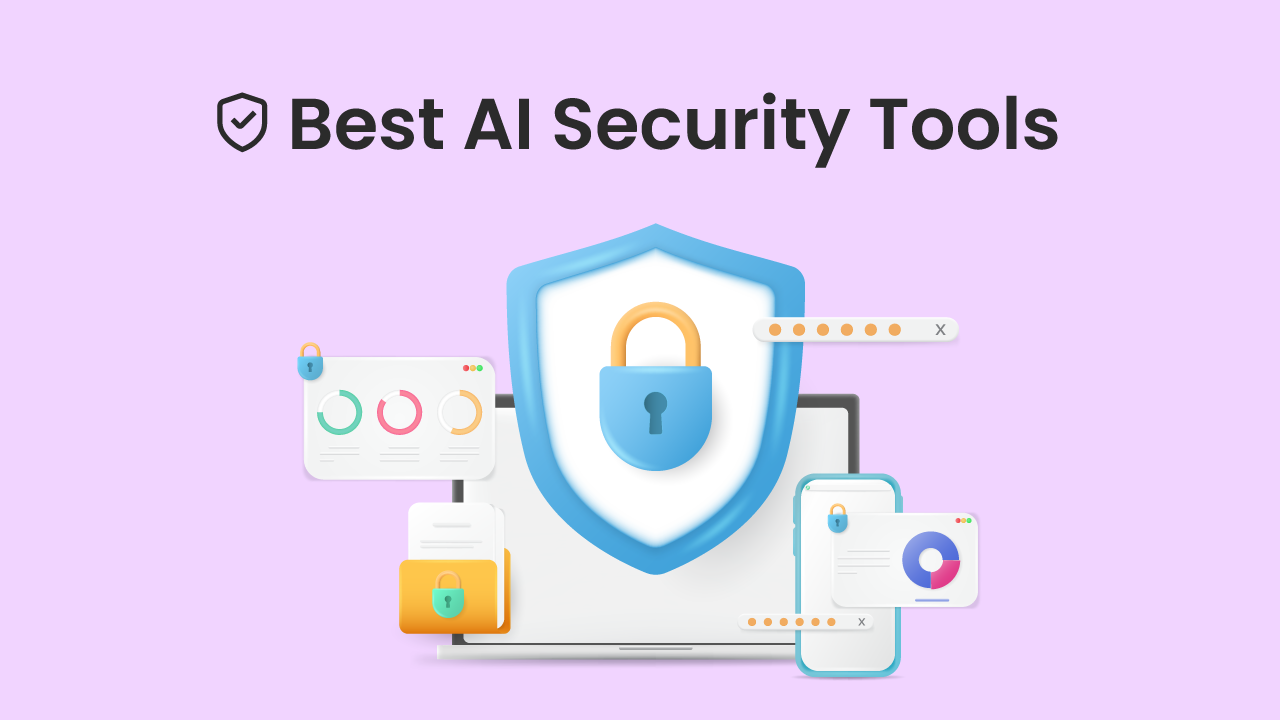With the rapid advancements in artificial intelligence (AI) technology, businesses are benefiting from improved efficiency, enhanced decision-making, and increased productivity. However, as AI becomes more pervasive, it also brings new security challenges and risks. To protect sensitive data, ensure privacy, and safeguard against potential AI-related threats, organizations need robust AI security tools. These tools leverage AI and machine learning techniques to detect and prevent cyber threats, mitigate vulnerabilities, and maintain the integrity of AI systems. In this era of heightened cybersecurity concerns, implementing AI security tools has become crucial for businesses to safeguard their AI-driven infrastructure and maintain a secure digital environment.
Table of Contents
ToggleThere Are The Some Best AI Security Tools Of 2024
1. Darktrace
Darktrace is an AI-powered cybersecurity platform that utilizes machine learning and AI algorithms to detect and respond to cyber threats in real time. It employs a self-learning approach to understand and adapt to an organization’s network, identifying anomalous behaviors and potential security incidents.
Darktrace’s Enterprise Immune System acts as a digital “immune system” for businesses, providing defense against advanced cyber threats, including insider threats, ransomware, and zero-day attacks. The platform analyzes network traffic, user behavior, and device activity to detect and respond to threats autonomously, ensuring swift and proactive defense. Darktrace’s AI algorithms continuously learn and evolve, staying ahead of emerging threats and helping organizations maintain a robust cybersecurity posture.
Also Read: WordPress Plugins That Help In Doubling Your Website Traffic
2. Cylance
Cylance, now part of BlackBerry, is a leading provider of AI-driven endpoint security solutions. It leverages artificial intelligence and machine learning algorithms to detect and prevent both known and unknown threats, including malware, ransomware, and advanced persistent threats. Cylance’s AI-based approach focuses on predictive security, analyzing file and network behavior to identify and block potential threats in real-time.
By using machine learning models, Cylance can accurately identify and stop emerging threats before they cause harm. The platform offers proactive threat hunting, automated threat response, and incident investigation capabilities to enhance security operations. Cylance’s lightweight agent and cloud-based architecture ensure minimal impact on system performance while providing robust protection.
3. Vectra AI
Vectra AI is a leading provider of AI-powered cybersecurity solutions focused on detecting and responding to advanced cyber attacks. Their platform leverages AI algorithms to continuously monitor network traffic, user behavior, and cloud environments in real-time, enabling organizations to detect and mitigate threats quickly.
Vectra AI’s approach is based on network detection and response (NDR), utilizing machine learning models to identify hidden threats, insider attacks, and other sophisticated cyber threats that may bypass traditional security measures. By analyzing network behavior patterns, Vectra AI detects anomalies, identifies potential security incidents, and provides actionable insights for effective incident response. The platform also offers threat-hunting capabilities and integrates with existing security infrastructure to enhance overall security operations.
Also Read: How to Create Temporary Login for WordPress (No Passwords)
4. SentinelOne
SentinelOne is a leading provider of AI-powered endpoint security solutions that protect against advanced cyber threats. Their platform combines machine learning, behavioral analysis, and automated response capabilities to detect, prevent, and respond to a wide range of attacks, including malware, ransomware, and file-less attacks. SentinelOne’s AI algorithms analyze endpoint activity in real-time, identifying suspicious behavior and taking proactive measures to stop threats before they can cause harm.
The platform offers advanced threat-hunting capabilities, allowing security teams to investigate and respond to incidents effectively. Additionally, SentinelOne’s autonomous response feature can automatically mitigate threats and roll back any changes made by malicious actors. The solution provides comprehensive visibility into endpoint security through a single console, simplifying management and ensuring comprehensive protection across the organization.
5. Cybereason
Cybereason is a leading provider of AI-powered cybersecurity solutions that help organizations detect, investigate, and respond to cyber threats effectively. Their platform utilizes AI and machine learning algorithms to analyze vast amounts of data and identify malicious activities in real-time. Cybereason’s approach focuses on endpoint protection, providing advanced threat-hunting capabilities, behavioral analytics, and automated response to counter sophisticated attacks.
The platform offers continuous monitoring and detection, enabling security teams to stay ahead of evolving threats. Cybereason’s AI algorithms can identify patterns, detect anomalies, and prioritize alerts to help security analysts streamline their investigations and take prompt action. Additionally, the platform provides actionable insights and visualizations to enhance threat intelligence and support proactive defense strategies.
Also Read: How to Convert Wix to WordPress?
6. McAfee MVISION
McAfee MVISION is a comprehensive cybersecurity platform that combines advanced technologies, including AI and machine learning, to provide proactive protection, threat intelligence, and unified management for organizations. MVISION offers a wide range of security capabilities, including endpoint security, cloud security, data protection, and threat detection and response.
With its AI-powered capabilities, MVISION can detect and prevent known and unknown threats across endpoints, networks, and cloud environments. The platform analyzes vast amounts of data in real-time to identify malicious activities, anomalies, and potential security incidents. It uses machine learning models to continuously improve its threat detection capabilities, allowing it to adapt and respond to emerging threats effectively.
MVISION provides holistic visibility and control across all endpoints and cloud environments, allowing organizations to enforce consistent security policies and protect their data wherever it resides. It offers advanced features such as data loss prevention (DLP), encryption, and user behavior analytics to ensure sensitive information is safeguarded.
The platform also integrates with other security solutions and threat intelligence sources, enabling organizations to enhance their security posture and automate incident response. MVISION’s centralized management console provides a unified view of security events, simplifying administration and enabling efficient security operations.
7. Fortinet FortiAI
Fortinet FortiAI is an AI-powered cybersecurity solution developed by Fortinet, a leading provider of network security appliances and services. FortiAI leverages machine learning and deep neural networks to enhance threat detection, automate security operations, and strengthen overall network security.
One of the key features of FortiAI is its ability to detect and classify previously unknown threats with high accuracy. By analyzing vast amounts of network traffic data and applying advanced AI algorithms, FortiAI can identify new and evolving threats that may bypass traditional security measures. This enables organizations to stay ahead of sophisticated attacks and proactively respond to emerging threats.
FortiAI also offers intelligent automation capabilities, enabling security teams to streamline their operations and reduce manual efforts. The solution automates routine tasks, such as threat hunting, incident response, and policy enforcement, allowing security analysts to focus on more strategic and complex security challenges.
Furthermore, FortiAI integrates seamlessly with the broader Fortinet security ecosystem, including FortiGate, FortiManager, and FortiAnalyzer, providing a comprehensive security framework for organizations. The integration allows for centralized management, real-time threat intelligence sharing, and unified visibility across the network.
By harnessing the power of AI, Fortinet FortiAI empowers organizations to enhance their cybersecurity defenses, improve threat detection and response capabilities, and mitigate the risks associated with advanced cyber threats.
Also Read: Engage Your Community with these top-secret techniques
8. Symantec Endpoint Protection
Symantec Endpoint Protection is a leading cybersecurity solution that combines advanced threat prevention, detection, and response capabilities to protect endpoints and defend against evolving cyber threats. It utilizes AI and machine learning techniques to provide proactive and effective security for organizations of all sizes.
Symantec Endpoint Protection employs a layered approach to security, integrating multiple security technologies to provide comprehensive protection against malware, ransomware, zero-day exploits, and other advanced threats. The AI-driven threat detection capabilities analyze file behavior, network communications, and system activities to identify and block both known and unknown threats in real time.
The solution also offers advanced behavioral analysis, which helps identify suspicious activities and potential indicators of compromise. With its machine learning algorithms, Symantec Endpoint Protection continuously learns and adapts to new and emerging threats, improving its detection accuracy over time.
Symantec Endpoint Protection includes features like firewall protection, intrusion prevention, device control, and web filtering to safeguard endpoints from various attack vectors. It also integrates seamlessly with Symantec’s cloud-based threat intelligence network, enabling organizations to benefit from real-time threat intelligence and global threat visibility.
With its centralized management console, Symantec Endpoint Protection provides administrators with a unified view of security events, enabling them to monitor and manage endpoints efficiently. The solution supports various platforms, including Windows, macOS, Linux, and virtual environments.
Conclusion
AI security tools have become essential in today’s cybersecurity landscape, where businesses face increasingly sophisticated and evolving threats. These tools leverage artificial intelligence, machine learning, and advanced analytics to provide proactive and effective protection against cyber attacks. By analyzing vast amounts of data, detecting anomalies, and identifying patterns, AI security tools can identify both known and unknown threats in real time, allowing organizations to respond swiftly and mitigate risks.
AI security tools offer several benefits, including enhanced threat detection capabilities, improved incident response, and reduced manual efforts for security teams. These tools can identify complex attack vectors, detect insider threats, and provide valuable insights into potential security incidents. They also help organizations stay ahead of emerging threats by continuously learning and adapting to new attack techniques.
Furthermore, AI security tools enable organizations to automate security processes, streamline security operations, and integrate with existing security infrastructure. This integration allows for centralized management, real-time threat intelligence sharing, and comprehensive visibility across the network, ensuring a holistic and coordinated approach to cybersecurity.
Frequently Asked Questions (FAQs)
AI security tools are software solutions that use artificial intelligence and machine learning to protect computer systems, networks, and data from cyber threats. They are important because they can detect and respond to threats in real-time, providing a proactive defense against evolving cybersecurity risks.
AI security tools differ from traditional solutions by their ability to analyze vast amounts of data, identify patterns, and detect anomalies in real-time. They can adapt to new threats without requiring constant manual updates, offering a more proactive and dynamic defense.
AI security tools can defend against a wide range of threats, including malware, ransomware, phishing attacks, insider threats, DDoS attacks, and zero-day vulnerabilities. They can also identify unusual behavior and potential data breaches.
AI security tools are suitable for organizations of all sizes, including small businesses. Many AI security solutions are scalable and can be tailored to meet the specific needs and budget constraints of smaller organizations.
Integrating AI security tools typically involves selecting a compatible solution, setting up the necessary hardware or software, configuring it to work with your existing systems, and providing training to your cybersecurity team. Many vendors offer support and guidance during the integration process to ensure a smooth transition.
Interesting Reads:
WordPress Plugins That Help In Doubling Your Website Traffic








